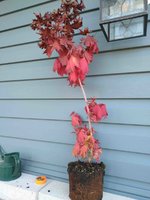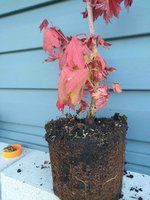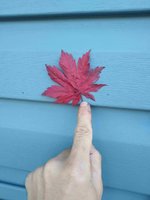You are using an out of date browser. It may not display this or other websites correctly.
You should upgrade or use an alternative browser.
You should upgrade or use an alternative browser.
Whats this JM cultivar?
- Thread starter The Warm Canuck
- Start date
rockm
Spuds Moyogi
Impossible to tell without an original tag. There are thousands of varieties of JM. Some are quite close in appearance. Could be one of the "full moon" shirasawanum cultivars, but that would be a complete guess based on leaf shape.
William N. Valavanis
Chumono
Not Acer palmatum, leaves are too wide and have too many points. Looks like a Full moon maple, Acer japonicum.
Shibui
Imperial Masterpiece
Agree with Acer japonicum ID. It is also sometimes called Japanese maple - beware of common names when referring to plants! - but a different species to the one we usually use for bonsai.
I think there are a few named cultivars of Acer japonicum but I do not know how to tell the differences.
I think there are a few named cultivars of Acer japonicum but I do not know how to tell the differences.
jradics
Mame
looks like Acontifolium. Full moon is a common nameJust bought this JM, just wondering if anyone has an idea of what cultivar it may be? View attachment 511687View attachment 511688View attachment 511689
jradics
Mame
I'd probably put it in a big pot,and try to air layer the top off while leaving the stuff at the base. Then start growing two trees
The Warm Canuck
Shohin
Why? it's not a graft. It was grown from seed.I'd probably put it in a big pot,and try to air layer the top off while leaving the stuff at the base. Then start growing two trees
The Warm Canuck
Shohin
Will Full Moons leaves not reduce to create a sufficient Bonsai? It can't be any worse than Acer Rubrum.looks like Acontifolium. Full moon is a common name
Paradox
Imperial Masterpiece
I am not sure if/how much the leaves reduce but if they dont, it might be more suitable as a larger bonsai.Will Full Moons leaves not reduce to create a sufficient Bonsai? It can't be any worse than Acer Rubrum.
The Warm Canuck
Shohin
I've been reading a bit about them, sounds like the leaves don't reduce well so I'll be growing it into a large bonsai.
 www.bonsainut.com
www.bonsainut.com
Acer j. Aconitifolium as Bonsai
Hi Folks Suggestions please as to the suitability of Acer j. Aconitifolium as bonsai material. I realise that it's leaves are a little larger than Acer palmatum and have heard that you cannot reduce their size like you can with palmatum. Any other problems with Aconitifolium? Fred
Then it’s definitely not a cultivar. Cultivars are only propagated asexually (i.e., by grafts, cuttings, air layers, or tissue culture).Why? it's not a graft. It was grown from seed.
The Warm Canuck
Shohin
Thank you for that clarification. I wasn't aware of that distinction.Then it’s definitely not a cultivar. Cultivars are only propagated asexually (i.e., by grafts, cuttings, air layers, or tissue culture).
The grower just told me that they are not grafted and it clearly isn't, so I just made that assumption, it possibly could have been grown from a cutting.
MaciekA
Shohin
Why? it's not a graft. It was grown from seed.
This is unlikely, but let me outline why
A Japanese Maple cultivar is the result of a search for a diamond in the rough, and cloning of that one diamond thereafter.
Either it is the result of hiking Japanese forests and finding an existing tree with a highly unusual genetic mutation OR it is the result of, in the style of Jean Iseli, planting 10s of 1000s of seedlings in a field and hoping one or two will come out with interesting characteristics. In both of these cases, all future trees which claim to be of that cultivar are clones of that first discovered tree or seedling.
Once an interesting wild tree or seedling is discovered in such a search, that genetic is branded/named, trademarked, and then cloned repeatedly through non-seed means (either grafting (the most common commercial method by a million miles), rooting cuttings (more common amongst bonsai people, especially through air layers), or a less well-known method called tissue culture which is more of a lab-style clone).
The key observation for this thread is that no other seed will ever produce that same genetic ever again. Even seeds from that tree will not reproduce that cultivar either. Every instance of that named cultivar found in the market from then on is a genetically-identical clone of that seedling/wild tree. If a world disaster were to occur and all currently-alive individuals of Shishigashira or Sharp's Pigmy were to die, then even if we had seeds from those trees in the seed vault, we wouldn't be able to get those cultivars back. They'd be gone except through a miracle of sequencing the dead trees + genetic engineering + CRISPR etc.
So the only case in which you have in your hands a tree which is both a "cultivar" in the literal sense and was grown from seed is if you are in possession of that first diamond-in-the-rough tree, i.e if you had in your hands that very first seedling that produced that unique snowflake of genetics. In that case, you are the discoverer. The cultivar name is your's to give ("Quinty Bay Beauty"?) and can't be found in a catalog. In that case, this forum wouldn't be able to tell you what the cultivar is.
In all other cases a cultivar has made its way to you via the cloning process and must be either a graft (99.9999% of cases), or a rooted cutting, or tissue culture. In ornamental/landscape tree markets, nobody will make a dime in the latter two methods, so it is really basically always grafting (you can read a bit about this written from a commercial point of view in Dirr's woody propagation manual). If you don't see a graft, it might actually be buried under the soil. It is very common in landscape nursery stock for the trunk base to be buried about half way into the height of the pot.
Anyway, it is possible that this is all a misunderstanding and you have indeed purchased a unique cultivar which a grower your area discovered and then for some unusual reason decided to sell to you in spite of it being the "Original Genetic Patient Zero", but, this seems kinda unlikely. I suggest going back to where it came from and insisting that they open up their order book and find who and when they ordered from , which catalog number, who the wholesaler was, etc. Cultivars don't just appear in nurseries by chance, they're consciously ordered by purchasing managers who look at a list and say "30 of cultivar ABC please, and 50 of XYZ". Hopefully you can dig and discover the cultivar name.
The Warm Canuck
Shohin
Thank you for the detailed explanation and education.This is unlikely, but let me outline why
A Japanese Maple cultivar is the result of a search for a diamond in the rough, and cloning of that one diamond thereafter.
Either it is the result of hiking Japanese forests and finding an existing tree with a highly unusual genetic mutation OR it is the result of, in the style of Jean Iseli, planting 10s of 1000s of seedlings in a field and hoping one or two will come out with interesting characteristics. In both of these cases, all future trees which claim to be of that cultivar are clones of that first discovered tree or seedling.
Once an interesting wild tree or seedling is discovered in such a search, that genetic is branded/named, trademarked, and then cloned repeatedly through non-seed means (either grafting (the most common commercial method by a million miles), rooting cuttings (more common amongst bonsai people, especially through air layers), or a less well-known method called tissue culture which is more of a lab-style clone).
The key observation for this thread is that no other seed will ever produce that same genetic ever again. Even seeds from that tree will not reproduce that cultivar either. Every instance of that named cultivar found in the market from then on is a genetically-identical clone of that seedling/wild tree. If a world disaster were to occur and all currently-alive individuals of Shishigashira or Sharp's Pigmy were to die, then even if we had seeds from those trees in the seed vault, we wouldn't be able to get those cultivars back. They'd be gone except through a miracle of sequencing the dead trees + genetic engineering + CRISPR etc.
So the only case in which you have in your hands a tree which is both a "cultivar" in the literal sense and was grown from seed is if you are in possession of that first diamond-in-the-rough tree, i.e if you had in your hands that very first seedling that produced that unique snowflake of genetics. In that case, you are the discoverer. The cultivar name is your's to give ("Quinty Bay Beauty"?) and can't be found in a catalog. In that case, this forum wouldn't be able to tell you what the cultivar is.
In all other cases a cultivar has made its way to you via the cloning process and must be either a graft (99.9999% of cases), or a rooted cutting, or tissue culture. In ornamental/landscape tree markets, nobody will make a dime in the latter two methods, so it is really basically always grafting (you can read a bit about this written from a commercial point of view in Dirr's woody propagation manual). If you don't see a graft, it might actually be buried under the soil. It is very common in landscape nursery stock for the trunk base to be buried about half way into the height of the pot.
Anyway, it is possible that this is all a misunderstanding and you have indeed purchased a unique cultivar which a grower your area discovered and then for some unusual reason decided to sell to you in spite of it being the "Original Genetic Patient Zero", but, this seems kinda unlikely. I suggest going back to where it came from and insisting that they open up their order book and find who and when they ordered from , which catalog number, who the wholesaler was, etc. Cultivars don't just appear in nurseries by chance, they're consciously ordered by purchasing managers who look at a list and say "30 of cultivar ABC please, and 50 of XYZ". Hopefully you can dig and discover the cultivar name.
I guess it must be a graft, I just can't see where. I'm so used to shitty nursery grafts that are so apparent. Regardless, unless the graft becomes more apparent, I'll grow it into a Bonsai. If not, I'll try air layering it.
Here's some more pics, maybe you guys can make out the graft. The only spot that I can see where it may be, is a bit over where the first shoots are, however, the leaves are the same as the ones further up the tree:
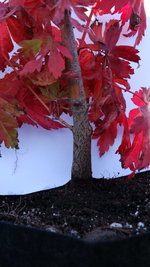
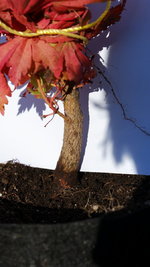
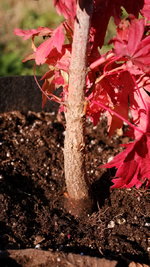
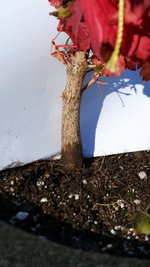
Japonicus
Imperial Masterpiece
I had japonicum 'Otaki' in ground 15 yrs. It died 2 yrs after cutting down an aspen tree resulting in more sunlight. The Fall colours were spectacular displaying multiple colours on single leaves from purples, reds oranges and yellows. Many leaves bigger than your hand.
rockm
Spuds Moyogi
I don't think it's a graft. My money would be on a clone (air layered or cutting grown)Thank you for the detailed explanation and education.
I guess it must be a graft, I just can't see where. I'm so used to shitty nursery grafts that are so apparent. Regardless, unless the graft becomes more apparent, I'll grow it into a Bonsai. If not, I'll try air layering it.
Here's some more pics, maybe you guys can make out the graft. The only spot that I can see where it may be, is a bit over where the first shoots are, however, the leaves are the same as the ones further up the tree:
View attachment 511822View attachment 511823View attachment 511824View attachment 511825
penumbra
Imperial Masterpiece
Acer rubrum leaves reduce pretty well.Will Full Moons leaves not reduce to create a sufficient Bonsai? It can't be any worse than Acer Rubrum.
River's Edge
Masterpiece
"Fullmoon is best grown in a sheltered position away from cold winds. Trees prefer a moist, well-drained soil and partial shade. Nice specimens can be seen growing in the filtered shade of tall, overstory trees, or with 2 to 6 hours of direct sun. Propagate by seed and by softwood cuttings collected in July." Quote from a well known Maple nursery.The grower just told me that they are not grafted and it clearly isn't, so I just made that assumption, it possibly could have been grown from a cutting
So the grower did not mislead you. Full Moon Maple is a common name for a maple type that can be propagated by seed or cutting! He did not identify it as a cultivar that came into the post by your question. No problem they are beautiful trees with the only issue being larger leaf size and thus not as desirable for Medium to small Bonsai. They do have the advantage of being cold hardy which is a big plus for your location.
Just did not want you to think the original information you received was false. That could easily be based on the comments and discussion that followed.
The Warm Canuck
Shohin
As always I much appreciate your clarification Frank!"Fullmoon is best grown in a sheltered position away from cold winds. Trees prefer a moist, well-drained soil and partial shade. Nice specimens can be seen growing in the filtered shade of tall, overstory trees, or with 2 to 6 hours of direct sun. Propagate by seed and by softwood cuttings collected in July." Quote from a well known Maple nursery.
So the grower did not mislead you. Full Moon Maple is a common name for a maple type that can be propagated by seed or cutting! He did not identify it as a cultivar that came into the post by your question. No problem they are beautiful trees with the only issue being larger leaf size and thus not as desirable for Medium to small Bonsai. They do have the advantage of being cold hardy which is a big plus for your location.
Just did not want you to think the original information you received was false. That could easily be based on the comments and discussion that followed.
I'm excited for this tree, it's not easy to find quality JM pre-bonsai and the like in my area. One day I hope to come visit your nursery.
xwintersgloomx
Seedling
Nice! It is tough to find cultivar's without rough grafts. I'm curious of the local nursery?
Similar threads
- Replies
- 5
- Views
- 234
- Replies
- 4
- Views
- 245

